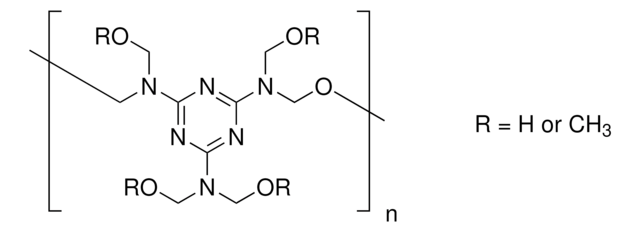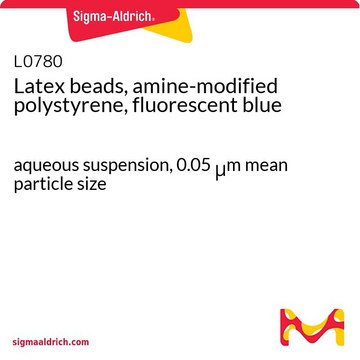LB5
Latex beads, polystyrene
0.46 μm mean particle size
Synonym(s):
Latex microspheres, Polystyrene beads, Polystyrene microspheres
Sign Into View Organizational & Contract Pricing
All Photos(1)
About This Item
Recommended Products
form
aqueous suspension
composition
Solids, 10%
packaging
pack of 1 mL
pack of 15 mL
pack of 2 mL
mean particle size
0.46 μm
Looking for similar products? Visit Product Comparison Guide
General description
Polystyrene microparticles are negativelycharged- stabilized colloidal particles. These microparticles are synthesizedby the polymerization of styrene under conditions that produce coalescent beadformation. Polystyrene latex beads have a broad range of applications such as cellcounter calibration, antibody-mediated agglutination diagnostics, electronmicroscopy, and phagocytosis experiments.
Application
Polystyrene latex beads have been used as a component of an artificial device to draw blood from mice. It has also been used as a component of the protein-free latex meal for the extraction of the peritrophic matrix (PM) from female Anopheles gambiae.
Hazard Statements
Precautionary Statements
Hazard Classifications
Aquatic Chronic 3
Storage Class Code
10 - Combustible liquids
WGK
WGK 3
Flash Point(F)
Not applicable
Flash Point(C)
Not applicable
Personal Protective Equipment
dust mask type N95 (US), Eyeshields, Gloves
Certificates of Analysis (COA)
Search for Certificates of Analysis (COA) by entering the products Lot/Batch Number. Lot and Batch Numbers can be found on a product’s label following the words ‘Lot’ or ‘Batch’.
Already Own This Product?
Find documentation for the products that you have recently purchased in the Document Library.
Customers Also Viewed
Presence of chitinase and beta-N-acetylglucosaminidase in the Aedes aegypti: a chitinolytic system involving peritrophic matrix formation and degradation
Benedito P D F, et al.
Insect Biochemistry and Molecular Biology, 32(12), 1723-1729 (2002)
Joanna Koziel et al.
PloS one, 4(4), e5210-e5210 (2009-04-22)
It is becoming increasingly apparent that Staphylococcus aureus are able to survive engulfment by macrophages, and that the intracellular environment of these host cells, which is essential to innate host defenses against invading microorganisms, may in fact provide a refuge
Je-Wen Liou et al.
PloS one, 6(5), e19982-e19982 (2011-05-19)
Recent research shows that visible-light responsive photocatalysts have potential usage in antimicrobial applications. However, the dynamic changes in the damage to photocatalyzed bacteria remain unclear. Facilitated by atomic force microscopy, this study analyzes the visible-light driven photocatalyst-mediated damage of Escherichia
Our team of scientists has experience in all areas of research including Life Science, Material Science, Chemical Synthesis, Chromatography, Analytical and many others.
Contact Technical Service








